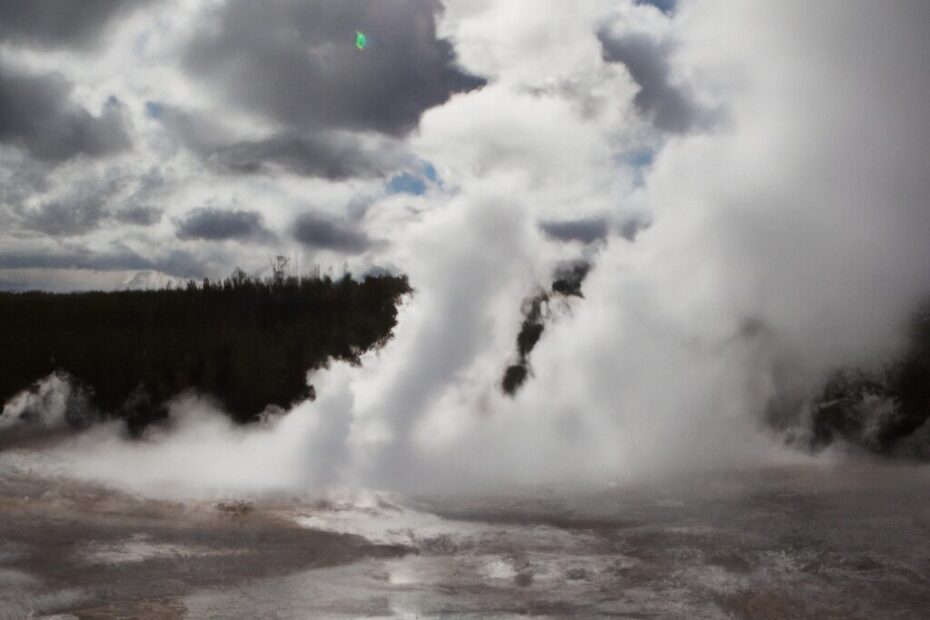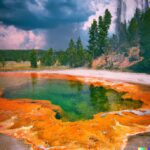Geysers, natural wonders that captivate our imagination with their powerful eruptions, are a fascinating phenomenon found in various parts of the world. The geysers in Yellowstone National Park hold a special place in the hearts of many.
In this article, we will explore the science behind geysers, what causes them to erupt, and the unique underground plumbing system that makes it all possible. We will also delve into the cultural and historical significance of geysers in Yellowstone, as well as the best ways to experience these majestic wonders in person.
So, get ready to be amazed by the magic of geysers in Yellowstone National Park!
What Are Geysers?
Geysers are fascinating thermal features that result from hydrothermal activity beneath the Earth’s surface, often characterized by intermittent eruptions of steam and hot water.
These incredible natural phenomena are primarily formed when groundwater seeps deep into the Earth’s crust and becomes heated by nearby magma chambers. As the water reaches extreme temperatures and pressures, it begins to boil and expand rapidly. Eventually, the built-up pressure causes a sudden release of steam and water, resulting in a spectacular eruption that can shoot water high into the air. Geysers are known for their cyclic nature, with periods of activity followed by periods of dormancy, making them a captivating sight for visitors to geothermal areas around the world.
What Causes Geysers to Erupt?
The eruption of geysers is primarily triggered by a combination of factors, including the build-up of pressure, the presence of a heat source, and the interaction of water and steam within the underground vent.
When water seeps into the earth’s crust and comes into contact with a heat source, such as magma chambers or hot rocks, it begins to heat up and expand rapidly. As the water transforms into steam, it creates intense pressure within the confined spaces of the underground vent. This pressure continues to mount until it overcomes the weight of the water column above it, leading to a sudden release of steam and hot water. Vents play a crucial role in this process, serving as the pathway for the explosive eruption of geysers, as they allow the built-up pressure to escape, resulting in the awe-inspiring displays that we observe at these natural wonders.
What Is the Role of Heat and Pressure?
Heat and pressure play crucial roles in the eruption cycle of geysers, where the increase in temperature and pressure underground leads to the eventual release of steam and water through the geyser’s vent.
This process begins with the heating of water deep within the Earth’s surface, usually by magma or hot rocks below. As the water gets heated, it starts to rise towards the surface due to the lower density of hot water. This rising hot water creates pressure within the geyser’s chamber, building up energy until it surpasses the pressure of the water column above it. Once the pressure becomes too great, the geyser erupts in a spectacular display, expelling a mixture of scalding water and steam high into the air.
How Does the Underground Plumbing System Work?
The underground plumbing system of geysers involves intricate networks of water reservoirs and geological formations that channel hot water and steam towards the surface, eventually culminating in spectacular eruptions.
These underground pathways play a crucial role in the behavior of geysers. Water from rain and snowmelt seeps through porous rock layers, creating underground reservoirs that gradually heat up due to the Earth’s internal heat. As this water heats up, it builds pressure within chambers beneath the surface, leading to the intermittent release of steam and water. The presence of geological faults and fractures further influences the direction and flow of underground water, ultimately shaping the unique characteristics of each geyser’s eruptions.
Where Can You Find Geysers?
Geysers can be found in various geothermal regions worldwide, with Yellowstone National Park standing out as a prominent tourist destination renowned for its spectacular geothermal features.
These natural wonders exist in a few select areas known for their geothermal activity, including Iceland’s Reykjanes Peninsula, New Zealand’s Rotorua, and Chile’s El Tatio. These regions boast a high concentration of geysers, captivating visitors with their awe-inspiring displays of boiling water shooting into the air.
None rival the fame and sheer number of geysers found within the vast expanse of Yellowstone. The geyser Old Faithful, in particular, has become an emblem of the park, attracting crowds with its reliable eruptions and picturesque surroundings.
What Is the Connection Between Geysers and Yellowstone National Park?
Yellowstone National Park is intricately linked to geysers, serving as a conservation area that protects these natural wonders and sustains a diverse ecosystem supported by geothermal features.
Spanning over 2.2 million acres, Yellowstone is home to around 500 geysers that play a vital role in shaping the park’s landscape and supporting various plant and animal species. These geothermal features not only provide unique habitats for organisms like thermophiles but also serve as critical sources of energy for the park’s volcanic activity. By safeguarding the geysers and their surrounding environment, Yellowstone National Park underscores the significance of balancing conservation efforts with preserving the delicate ecosystems that rely on these natural manifestations.
What Makes Yellowstone National Park Unique in Terms of Geysers?
Yellowstone National Park stands out for its exceptional geothermal features, including geysers, which are among its most unique attractions drawing visitors from around the world.
These geysers serve as iconic symbols of the park’s natural wonders, spouting hot water and steam into the air in a mesmerizing display of raw power and beauty. Old Faithful, perhaps the most famous geyser in the park, captivates spectators with its regular and predictable eruptions, creating a sense of awe and anticipation among those lucky enough to witness its breathtaking spectacle. The otherworldly landscapes surrounding these geothermal marvels add to the park’s allure, making it a must-visit destination for nature lovers and adventure seekers alike.
What Is the Largest Geyser in Yellowstone National Park?
The largest geyser in Yellowstone National Park is the impressive Steamboat Geyser, known for its towering eruptions that captivate visitors with their grandeur and power.
Steamboat Geyser stands out not only for its size but also for its sporadic eruption patterns, unlike the more predictable Old Faithful. Its eruptions can reach up to 300 feet in height, making it the tallest active geyser in the world. While Old Faithful erupts at regular intervals, Steamboat’s eruptions are more infrequent and unpredictable, adding to its mystique. Despite this irregularity, witnessing a Steamboat eruption is a unique and enthralling experience for visitors to Yellowstone National Park.
What Are the Most Popular Geysers in Yellowstone National Park?
Among the most popular geysers in Yellowstone National Park is the iconic Old Faithful, renowned for its predictable eruptions that have fascinated generations of visitors.
Visitors flock to witness the awe-inspiring eruption of Old Faithful, which shoots scalding water up to 180 feet in the air with remarkable consistency. This geyser derives its name from its reliable eruptions that occur roughly every 90 minutes, captivating spectators with its impressive display of natural power.
Alongside Old Faithful, other notable geysers like Grand Geyser and Steamboat Geyser also attract attention with their own unique characteristics and eruption patterns, adding to the allure of Yellowstone’s geothermal wonders.
Why Are Geysers Significant in Yellowstone National Park?
Geysers play a vital role in the ecological balance of Yellowstone National Park, contributing to the health of the ecosystem through their geothermal influence and unique geological processes.
Their continuous release of hot water and minerals not only shapes the physical landscape but also provides habitat for specialized microbial communities. These microbial mats thrive in the extreme conditions created by the geysers, contributing to the park’s biodiversity. By supporting diverse life forms, geysers aid in conservation efforts, maintaining a delicate balance within the ecosystem. The thermal features of geysers help regulate nutrient cycles, ensuring the sustainability of plant and animal populations within Yellowstone.
How Do Geysers Contribute to the Ecosystem?
Geysers contribute significantly to the ecosystem of Yellowstone National Park by supporting biodiversity conservation efforts, providing unique habitats for rare species, and sustaining ecological balances through geothermal influences.
These natural features act as hot springs that create specialized environments for a variety of organisms to thrive. The unique conditions around geysers support the growth of rare plant species and provide a home for microbial life that is crucial for nutrient cycling.
The geothermal activity around geysers influences the surrounding landscape, shaping the distribution of flora and fauna. By serving as hotspots of biodiversity and fostering distinct ecosystems, geysers play a vital role in maintaining the ecological richness of Yellowstone National Park.
What Is the Cultural and Historical Significance of Geysers in Yellowstone National Park?
Geysers hold immense cultural and historical significance in Yellowstone National Park, serving as iconic symbols of natural beauty and geological wonders that have captivated visitors for centuries.
The geysers in this pristine national park are not just stunning natural phenomena but are also a testament to the Earth’s immense power and geological history. Standing witness to the ever-changing landscape, these geothermal features evoke a sense of wonder and awe, drawing in millions of visitors annually. From Old Faithful with its predictable eruptions to lesser-known geysers tucked away in remote corners, each of these thermal wonders adds to the park’s allure and mystique. Their rhythmic bursts of steam and water create a mesmerizing spectacle, shaping Yellowstone’s identity as a premier natural wonder in the world.
How Are Geysers Monitored and Studied in Yellowstone National Park?
Geysers in Yellowstone National Park are meticulously monitored and studied through scientific research initiatives that aim to understand their behavior, eruption patterns, and underlying geological processes.
- Researchers deploy a range of monitoring techniques such as seismic sensors, thermal imaging, and satellite observations to gather data on geyser activity.
- This data is crucial in predicting eruptions, studying changes in thermal features, and assessing the health of the geothermal system within the park.
- Geologists play a key role in analyzing this data to decipher the mechanisms behind geyser eruptions, providing valuable insights into the geological processes at work beneath the surface.
What Are the Best Ways to Experience Geysers in Yellowstone National Park?
Experiencing geysers in Yellowstone National Park is best done through guided tours, nature walks, and ranger-led programs that offer insights into the geological wonders, ecosystem dynamics, and conservation efforts related to these natural attractions.
- Engaging in guided tours allows you to delve deeper into the history and science behind the geysers, led by knowledgeable experts who share fascinating stories about these natural marvels.
- Educational walks amidst the bubbling pools and steaming vents provide a close-up look at the unique geothermal features and the diverse flora and fauna that thrive in this dynamic environment.
- Participation in ranger-led programs offers interactive experiences that promote understanding and appreciation for the delicate balance of nature, as well as the crucial role of conservation in preserving these extraordinary landscapes.
Last Updated on February 8, 2024 by Jon Waraas – Originally Posted: February 8, 2024

I’m Jon Waraas, and I’ve been navigating the online world since 2006. By day, I’m the proud owner of some eCommerce gems, and by night, I’m the voice behind the adventures on Waraas.Com.
My heart, however, belongs to the wild beauty of Yellowstone National Park. I’ve got a collection of websites dedicated to sharing the wonders of this natural masterpiece. Oh, and did I mention? I’m currently building my own cabin inside the ghost town of Gilmore, Idaho – a cabin with tales to tell!
When I’m not immersed in the digital realm, you’ll find me lacing up my boots for a good hike or setting up camp under the star-studded sky.




